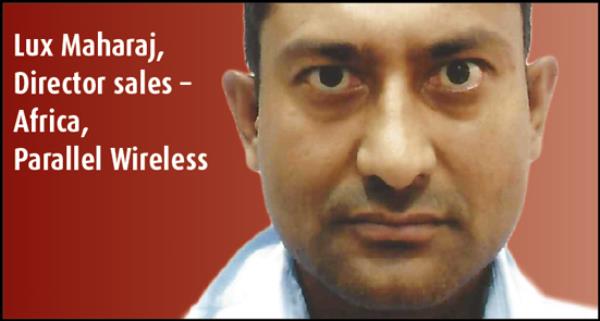07 March 2019

With only three per cent of Africa’s population predicted to be using 5G by 2025, should operators focus on connecting the unconnected or on deploying the latest mobile technology?
Virtualisation will help drive Africa’s journey towards the 5G era, as LUX MAHARAJ explains.
5G technology has already started to make its presence felt in Africa. MTN and Vodacom are in the process of conducting 5G trials, and recently South African operator Rain announced that it would be launching services soon. It is heartening to see Africa taking significant steps towards the deployment of 5G in the region.
At the same time, the service providers face tough choices, since nearly 600 million African citizens continue to be without basic connectivity. Even today, the continent is one of the most under-penetrated regions in the world with even primary 2G networks yet to reach more than 110 million people, according to a GSMA report.
Meanwhile, internet penetration in Africa is still at just 25 to 30 per cent against the global average of 43 per cent. Smartphone usage in the sub-Saharan region is only 34 per cent as compared to 57 per cent globally. As has been well documented, affordable communications is crucial to overall social and economic growth; it opens up new business opportunities and promotes entrepreneurship. More importantly, access to connectivity is known to lead to expansion of education opportunities and improves access to government services.
While African telcos have started exploring 5G, the GSMA predicts that only three per cent of the continent’s population will be using 5G by 2025. Should service providers therefore focus on connecting the unconnected or on deploying 5G networks?
Growing relevance of 5G in Africa
Going beyond popular use cases such as remote surgery and autonomous driving, 5G offers a number of other applications that are extremely relevant to Africa. The technology can help the region in addressing the problems of poverty and challenges in accessing the infrastructure. The relevant authorities can use the technology to provide e-learning and e-health through digital platforms, and improved literacy promotes social inclusion.

5G technology promises sustainable development and is an opportunity for developing regions like Africa to use digital platforms for the social and economic growth of the people. The use cases are immense and promise to change the way people live and work in the 5G era, with overall economic growth helping to reduce poverty in the region.
A few use cases that are especially relevant to a growing country include transformation of public safety and disaster relief infrastructure, remote surgery, a more efficient waste management system, among others. And because 5G technology enables low latency and ultra-high-speed mobile broadband, it allows many innovative use cases. Unlike previous standards, 5G is not just about a faster network. AR, VR, IoT and automation are some of its many smart applications. For enterprises, the technology promises to come up with many uses to improve processes and enhance productivity. Innovative and disruptive use cases mean that service providers will be able to come up with new revenue streams.
Present-day networks are not capable of addressing the vastly different and dynamic requirements of 5G technology. Africa’s service providers will need to adopt new technology approaches to prepare for the fifth generation era. The three technology concepts of network densification, network slicing and, most importantly, virtualisation, are likely to play key role in the networks of the future.
Network densification:
Global Mobile Data Traffic Forecast Update says mobile data traffic has been growing by 60 to 100 per cent every year and that total traffic will rise seven-fold between 2016 and 2021. This unprecedented growth in data traffic is fuelling the demand for network densification. This has already started with 4G/LTE but is likely to gather pace with 5G, since there will be more connected devices using the technology, with 20 billion connected devices likely by 2020. Further, as the IIoT (Industrial Internet of Things) catches on, service providers will need to add to network infrastructure in order to boost capacity and ensure quality of experience.
What’s more, low latency of less than one millisecond in 5G is only possible with network densification. Service providers will therefore need to ensure that the user devices are closer to the content providers’ data centres. Thus, service providers will need to add more macro and small cells to enhance the quality and capacity of the network.
Network slicing:
By dividing a network, each part can function as a separate, virtualised network. This approach allows mobile operators to offer customised services to a different set of clients in the same network.
Network slicing will help in bringing down opex while at the same time adding to service provider revenues. It also helps in faster scalability of operations, especially in the IoT.
.jpg)
By using virtualisation, operators can continue to support 2G while at the same time preparing their networks for 5G.
A vast number of IoT devices, including cars, wearables, machines and meters are going to be connected, and network operators will need to support different services. They will need to deploy networks for different service types over one infrastructure. The concept of network slicing will allow them to offer different type of services over one infrastructure. The providers will be able to bring new services rapidly in keeping with changing market dynamics.
Slices can be defined in keeping with the requirements. The control and user planes for every slice remains different and there is no impact on the user experience.
Virtualisation:
This involves moving from a primarily hardware-based system to software-based infrastructure. Since it is software-driven, the network consumes much less energy and space, and it is also easier to upgrade and manage the network.
Virtualisation is especially relevant to address the digital divide in Africa and, at the same time, prepare networks for 5G rollout. Shifting the network to a virtualised platform means that the service providers will be able to meet the requirements of their 2G subscribers and still be ready to move to 3G, 4G or 5G as and when the market is prepared, or when it is commercially viable to move to new technology.
Right now, the telcos are reluctant to invest in expensive 2G equipment to expand, and the market is not yet ready for 5G. Virtualisation resolves this dilemma. This way, operators are able to respond to market demand without making major changes to their networks. At the same time, they are ready to move to newer technology in keeping with that demand.
Virtualisation also comes with self-optimising and self-organising capabilities, making it easier to deploy and manage. It also makes it easier for service providers to expand in newer geographies as the cost of network deployment and management significantly comes down with virtualisation.
The solution is part of the Facebook-led Open RAN Telecom Infra Project (TIP) initiative to promote innovation, and has already been successfully deployed by operators such as Telefonica and Vodafone. The Open RAN initiative was started to bring down the cost of radio access networks by segregating hardware and software components. It also uses white box equipment to reduce the capex involved in setting up the network. Bringing down the cost of network infrastructure will help telcos to expand in newer geographies, offer better tariffs to their subscribers, and thus bridge the digital divide.
Easy and affordable access to communication services is crucial to Africa’s overall social and economic growth. 5G technology can play a vital role in connecting the unconnected, and also help the continent in addressing major issues such as challenges in accessing state infrastructure. Meanwhile, virtualised 2G can support telcos in expanding their networks to reach new subscribers. That means operators continue to support 2G networks while at the same time preparing their networks for 5G.

Unprecedented growth in data traffic is fuelling demand for network densification. This has already started with 4G/LTE but is likely to gather pace with 5G.






